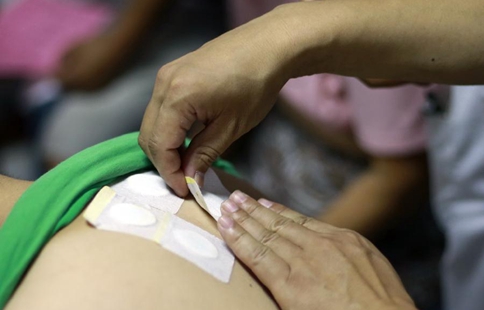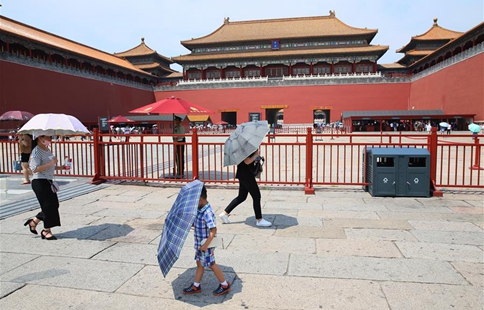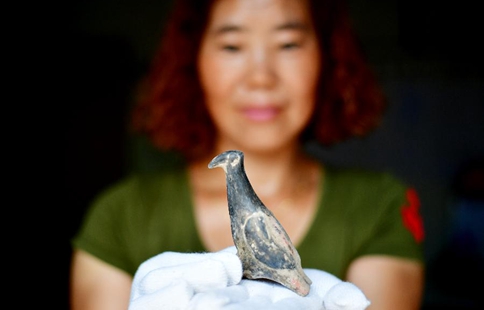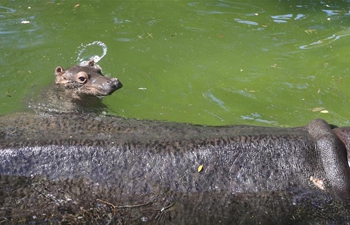by Liu Fang, Zindziwe Janse
THE HAGUE, July 12 (Xinhua) -- Chinese villagers who want to get back their stolen Buddha statue with in it a mummified body of an 11th-century monk will face the Dutch collector in the court of Amsterdam on Friday afternoon.
After going through documents filed by both parties, Xinhua presents here the key issues on admissibility, procedures and merits that might be discussed at the first public hearing of this case.
CAN CHINESE VILLAGE COMMITTEE STAND AT DUTCH COURT?
Villagers from two villages in China's southeastern province of Fujian had their village committees to file the claim that the mummified body, or "Master Zhang Gong" as called and worshipped during the past centuries, should be returned and placed back in their village temple.
In his answer to the claims, Oscar van Overeem, an Amsterdam-based architect and experienced art collector, argued that a "village committee is not to be referred to as a natural person or legal person" under the Dutch Code of Civil Procedure and "the claimants should be declared inadmissible in their claims."
The villagers then filed additional documents to explain that under the Chinese law, a village committee, as a special legal person, is entitled to attend litigation as a party based on legal provisions or authorizations from villagers. In practice, there are a great number of cases in which villagers' committees are claimants or defendants in lawsuits.
"The judge in the Netherlands has the responsibility to first check whether the parties have legal representation power. It is possible that they do not fully understand the legal personalities of village committees under the Chinese Law. I will give more information about this at the hearing," Dutch lawyer Jan Holthuis, who represents the Chinese villagers in Dutch court proceedings, told Xinhua.
PRESUMPTION OF FRAUD?
The defendant said that with a "swap agreement" reached on Nov. 29, 2015, Van Overeem has exchanged the statue against several Buddhist art objects from the private collection of a third party and committed to the third party to not disclose his identity.
A letter signed by his insurer was submitted as proof. "The Song dynasty mummy is insured by us since the commencing date of the first policy and at the most recent time for a sum of 950,000 euro. However, this object is at the moment no longer insured by us, this in connection with an exchange-swap of the object as reported by you [Van Overeem] to us," it stated.
The villagers ask the court to demand the Dutch collector disclose the "exchange agreement" and the identity of the "third party". For them, the exchange agreement is contrary to common decency and public order and therefore is void.
They also filed emails sent by the Dutch collector, reading "I can 'just' act, discuss and make decisions on behalf of him [the third party]."
"It is a 'presumption of fraud', or an 'action pauliana'. By making the statue away, the defendant causes in our view a presumption of a fraudulent act, namely preventing the enforcement of a claim of the villagers to return Zhang Gong, if the court would so decide," commented Holthuis.
"The defendant also said this third party is fully aware of the situation, which means, this third party can never be in good faith," he added.
IS THIS A CORPSE?
The villagers claim that the intact mummy of the monk Liu Quan is a "corpse" of an identifiable person as defined in the Dutch Burials and Cremations Act. A corpse cannot be subject to ownership according to this Act.
"Master Zhang Gong was famous during his life as a spiritual leader, because of his help to those who needed it and because of his healing powers. Upon his death his body was protected against rotting through herbs and other means. Thereafter the body is protected with a layer of lacquer and covered with a gold layer," said Liu Yushen, a Beijing registered lawyer who provides legal supports to the villagers.
"The likely wish of monk Zhang Gong Liu Quan is that through mummification, he would after his death continue to have a spiritual and healing power on his environment, and he would certainly not have agreed that his body would become the subject of (illegal) art trade," Liu told Xinhua.
"For the villagers who live in a region of the root of Buddhism in China, mummification has a special meaning. It implies that the body of the enlightened Buddhist monk remains part of the human world and can still be defiled after his death through external influences. From generation to generation the statue is worshipped and the day of the death of the monk is up to the present day memorized by ceremonies of piety," he added.
The Dutch collector argues that what was discovered in his statue was not a "corpse" but "human remains" because "most of the organs are absent". He filed several articles reporting on the selling, buying, and auctioning of mummies in the United States, Canada, Britain, etc., to support his opinion that a statue with a mummy inside is a "thing" and therefore object to ownership.
"There is case law that even a body without a head or without arms and legs is a corpse. In this case we have a complete body, and it is not an anonymous body, but a body that we have identified with a name. So I am confident in defending the villagers's claim," said Holthuis.
ARE THERE TWO STATUES?
The Dutch collector states that the Buddha statue that he bought is not the stolen statue from Yangchun village in China.
One of his main arguments is that a collector named Benny Rustenburg has acquired the statue at the end of 1994/the beginning of 1995 in Hong Kong -- well before the date of theft claimed by the villagers (Dec. 14, 1995), after which Rustenburg had the statue transported from Hong Kong to Amsterdam in mid-1995.
However, he does not provide concrete and substantial documents to support this narration.
One of the key arguments cited by the villagers comes from an article published in the catalogue of the special exhibition at the Drents Museum in the Netherlands, of which the statue was part.
"C14 dating methods confirmed that the mummy died between 1022 and 1155. During restauration a linen roll was found with two columns of Chinese characters. The name of the holy person is mentioned 'Liu Quan'. X-rays show an intact skeleton. The cause of death is even attributed to a tooth abscess," read the article written by a researcher commissioned by the Dutch collector.
"Not even mentioning the obvious similarities in posture and physique between the Buddha bought by Van Overeem and the Buddha on the few old pictures kept by the villagers, just the fact that 'Liu Quan', the name of the monk, and 'Pu Zhao Tang', the name of the village temple, as well as other Chinese characters, are written on the linen roll, is already decisive reference that this statue is the same statue as the one stolen from the village," said Liu Yushen.
GOOD FAITH OR NOT?
The villagers believe that the acquisition of the statue by Van Overeem was not in good faith.
"At the time of this acquisition, Hong Kong was a known place for trading of stolen Chinese art. Being a specialized trader and collector of Asian art, he should have asked for documented provenance of the statue and export documentation evidencing that the statue was not illegally exported from China," they stated in the claims.
And, he "knew, or should have known, given the price he paid for the statue, that the statue was a valuable Buddhist relic".
The Dutch collector challenged the claim by stating that he is an architect, not a specialized trader and collector of Asian art; he bought the statue in Amsterdam, not in Hong Kong or the mainland of China; and in the period concerned, in Hong Kong no import and export restrictions applied.
He added that under the Dutch Civil Code, he is presumed to be in good faith and the claimants have to prove that this is not the case. "Whoever is possessor in good faith, stays possessor in good faith, even though he at a later moment in time is informed that he is not the beneficiary."
"Many specialized art collectors have other jobs. Mr. Van Overeem could be both architect and specialized art dealer and collector at the same time. These two identities are not contradictory," commented Huo Zhengxin, vice-director of the School of International Law at the China University of Political Sciences and Law.
"Several documents filed by himself refer to him as being 'an active' or 'experienced' collector. For an active and experienced collector, a higher standard for duty of diligent investigations must apply. We have good reasons to believe that Mr. Van Overeem was not in good faith," he added.
The first hearing will last one hour. "Most likely, following the hearing, the court will issue a procedural order asking for a new exchange of statements to challenge. This would be the next step of the case," said the Dutch lawyer who represents the Chinese villagers.

















